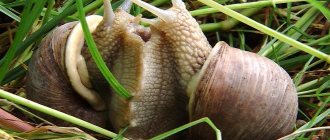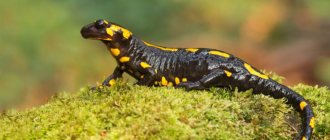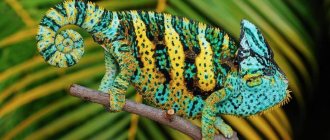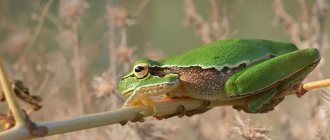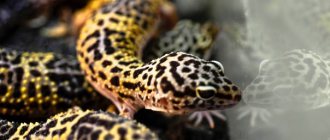How to maintain?
Keeping a corn snake, or as it is popularly called gutata, is not at all difficult. Like any living creatures, they need warmth and food, and snakes are no exception in this regard. For them, a normal room temperature of 25-26 degrees is sufficient, and at the warming point 30-32 degrees.
As for the terrarium, much depends on the size of the snake itself. If the snake is small (20-25 cm), then I prefer to keep such snakes in plastic containers with artificial horizontal ventilation. This is done so that the snake can quickly find food.
The advantage of professional terrariums is the ability to install the necessary lamps (incandescent and ultraviolet) and drinking bowls. Speaking of drinking bowls. In the house of maize it must be. Usually in a snake’s house the drinking bowl and bathing bowl are one whole. If the water is changed regularly, then this combination is quite natural for the snake.
Driftwood and stones will not be out of place in the maize snake terrarium. This is necessary so that the snake rubs against them during molting.
And one more important tip. Whatever home you choose for your snake, make sure that all lids close very tightly, ideally latching. If a small snake runs away, it will be almost impossible to find it even in an apartment!
Feed selection
In their natural habitat, corn snakes prefer rodents, birds, bird eggs, bats, and small amphibians. But at home, the menu of these reptiles is usually limited to laboratory or specially bred mice. This eliminates all questions regarding what to feed the corn snake, since there are no problems with purchasing such food - it can be regularly purchased at pet stores or from specialists involved in breeding food rodents.
But you should know in advance about choosing the correct size of the food object (FO) and other feeding features.
How to tame?
Everything else is just the pleasure of communicating with maize. If you do not pick up the kitten, it will also be wild. He will bite, scratch and yell obscenities. It's the same with snakes. Over time, any snake can be tamed. In the case of the corn snake, domestication occurs very quickly. Take the snake in your hands two or three times, and it will become tame for you for life.
Fresh and frozen food items?
Of course, it is best to feed frozen KO (hereinafter referred to as Frozen) for the following reasons:
Humaneness - Not everyone is ready to feed rodents live to their snake. From a moral point of view, it is much easier to feed your pet defrosted food.
Availability - Frozen food is always easier to find on sale than live food. Plus it's always cheaper.
Safety - Freezing is always a safer food, since the frozen state kills almost all the parasites that could be in the KO, as well as on the KO’s fur. Accordingly, when feeding by freezing, the risk of infecting your snake with mites tends to zero.
In general, frozen mice are in no way inferior to live mice in terms of nutritional and energy value, and bringing them into a fresh state is quite simple. To do this, simply remove the mouse from the freezer a few hours before feeding so that it has time to thaw and warm up to ambient temperature.
In cases where the previous owner’s corn snake is accustomed to feeding on live mice, the thawed mouse can be further warmed by placing it under a lamp or in warm water (previously wrapped in a bag) so that it acquires the temperature of a living rodent, 36-38°C.
The main rule is that there should be no partially defrosted fragments left in the food item.
Heating in a steam bath or in the microwave is recommended only in special cases, for example, when you urgently need to feed the snake. This emergency defrosting reduces the quality of the feed. In addition, this should be done very carefully so that the food is defrosted and not cooked.
Feed animation . How to “freeze” feed a corn snake if it is already accustomed to eating live mice is one of the most common questions. These reptiles quickly get used to the new feeding format and will soon happily eat defrosted food. But first you may need some animation. Taking the mouse with tweezers, you should move it from side to side to interest the snake. Also, before doing this, do not forget to warm it up, as mentioned above.
Size of the food object . The food should “grow” along with the corn snake. But it should not be thicker than the body of the snake itself in the place with the largest girth. It is necessary to increase the size of food objects gradually and consistently - “jumping” from a naked mouse to a runner is unacceptable.
The sequence of increasing food as the snake grows is as follows: pebbles, velvet mice, hairy mice, runners, adult mice.
Another important nuance: giving an adult snake 5-7 pebbles instead of one adult mouse is wrong. The volume of feed in both cases will be the same, but the nutritional value will be different. And the snake will not receive all the substances it needs.
Wild and “artificial” food . Sometimes the temptation to treat your snake to a “natural” mouse or lizard is very great. But in almost 100% of cases such animals are carriers of helminths and reservoirs for various pathogens. Therefore, it is wiser to give preference to food items that are specially grown for this purpose. Although even in this case there is no 100% guarantee that the snake will not get helminthiasis along with the food, the probability of this is significantly lower than when feeding “wild” mice.
Vitamin supplements . With proper maintenance and feeding, feeding with vitamins is not necessary. The corn snake gets everything it needs from high-quality food. But if there is a suspicion that the food items were not grown correctly (for example, not on a high-quality diet), then vitamin and mineral supplements may be useful.
Description and varieties
The length of this reptile is 1−1.5 m. The average life expectancy is 8−9 years. It is difficult to find out how long the corn snake lives based on morphological characteristics. It is necessary to understand how quickly an animal grows and develops. The snake is active at dawn and at night , because at this time it hunts.
The corn snake's natural coloration is orange-gold with black and red stripes. However, morphs—groups of snakes with genetic abnormalities—are often found in nature. They differ only in color, other features are preserved.
Popular ones include:
- Amelanism. Reptiles have a red or whitish-pink hue. They lack black pigment.
- Hypomelanism. Morphs are brown, gray or light brown with ventral scales.
The meiss snake is active at night, at this time it hunts - Charcoal. Reptiles in gray and brown shades. There is no yellow pigment.
- Anerythrysm. The animals are light gray in color with small patches of yellow on the neck and lower abdomen. There is no red pigment.
- Caramel. Reptiles with a mutation that suppresses red pigment. They “replace” it with yellow tones.
- Lava. Characterized by a monochromatic dark color with a predominant black color.
- Lavender. Melanin is practically absent. Therefore, the color of the morph varies from lavender to coffee, pink.
- Emory. The main color is gray with a bluish tint. The spots are colored in a carrot tone with slight darkening around the edges.
- Blizzard. The snake has white scales. Rarely can you find a yellow spot on it.
The listed morphs live in deciduous forests, near rocky slopes, and on barren soils. The largest population is located near farms throughout America, in the provinces of Mexico, and in the Cayman Islands.
Feeding regimen
The frequency of feedings decreases as the snake grows. A newborn snake needs to be fed once every 5-7 days. For adults - once every 7-10 days. And for an adult snake, 2-3 feedings per month are enough.
But it is better to select the feeding regimen individually, taking into account the above recommendations. The main guideline is the behavior of the snake. A healthy snake, being well-fed, is not particularly active. But when she is hungry, she becomes more mobile and can “scour” the terrarium in search of food. This means it's time to feed the corn snake.
Another important landmark is the return of the reptile to its previous size. After eating, her body increases in diameter, and takes its previous shape only after the food is completely digested.
Corn snake
Corn snakes are a group of non-venomous snakes that can be found in the southeastern United States. These reptiles are also called grain snakes. They inhabit fields, meadows, forests and rural areas (such as abandoned buildings and barns), which provide plenty of food. In addition, corn snakes can be found not only in the wild, but also in numerous homes around the world where they are kept as pets. These reptiles have become so popular because of their unusual appearance and fairly docile disposition. The main threats to the survival of corn snakes are habitat destruction and accidental killings. Fortunately, the number of corn snakes in the wild is still stable and they are not on the endangered species list.
Interesting Facts About Corn Snakes:
Corn snakes have a slender body that can reach lengths ranging from 24 to 72 inches. Snakes of this species are usually orange or dark yellow in color. They have red spots and stripes on the back and sides of the body. The belly is covered with black and white stripes. Body color depends on the habitat (it provides camouflage).
The corn snake's belly looks like the kernel of an Indian corn, hence the name "corn snake." Additionally, corn snakes are often found near corn, which attracts their favorite food, rodents.
Corn snakes are not venomous. Unfortunately, people often kill corn snakes because they are similar in appearance to the venomous snake known as the medhead.
Corn snakes are diurnal animals (active during the day). When they're not looking for food, corn snakes hide in underground burrows or under rocks and bark. Corn snakes can also be seen in trees.
Corn snakes are carnivores (meat eaters). Young corn snakes eat lizards and frogs, while adults hunt rodents, bats and birds, and sometimes eat bird eggs.
People value these snakes because they control the number of rodents. They also prevent the spread of disease and crop damage that is commonly associated with large rodent populations.
Corn snakes belong to a group of snakes known as constrictors. These snakes wrap the body around the victim and squeeze it until it suffocates.
Corn snakes require food every couple of days. When the prey is dead, the corn snake swallows it in one piece.
Corn snakes hibernate during cold periods of the year.
Mating season for corn snakes typically occurs from March to May.
The female lays 10 to 30 eggs in a nest of leaves or rotten wood. After that, she leaves them to their fate. The eggs hatch after an incubation period of 60 to 65 days.
Corn snakes do not exhibit parental care. The cubs are only 10-15 inches long at birth and need to be cared for from the first day of their life.
Corn snakes reach sexual maturity between 18 and 36 months of age.
Corn snakes can live 5 to 8 years in the wild and up to 25 years in captivity.
